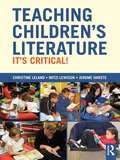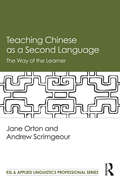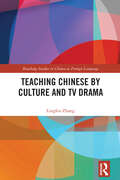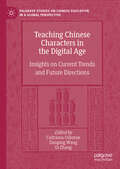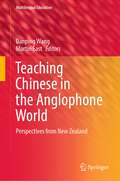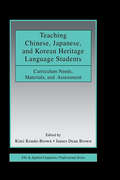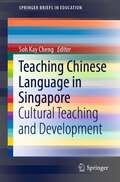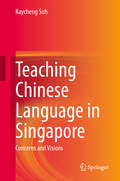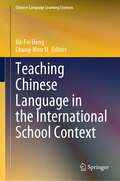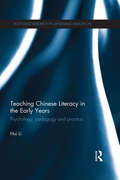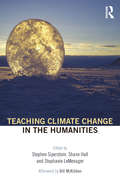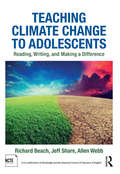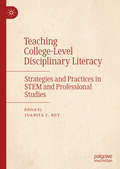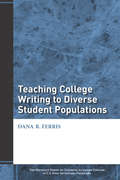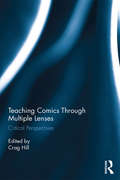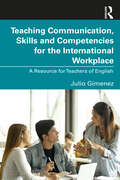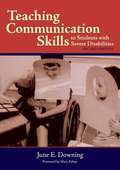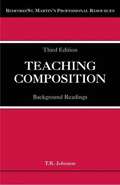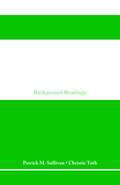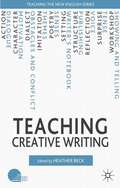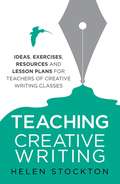- Table View
- List View
Teaching Children's Literature
by Mitzi Lewison Christine Leland Jerome HarsteThis groundbreaking text offers a fresh perspective on how to implement children's literature into and across the curriculum in ways that are both effective and purposeful. Honed over years of experience and reflection in classroom settings and rich with real examples of teachers implementing critical pedagogy, it invites multiple ways of engaging with literature that extend beyond the genre and elements approach and also addresses potential problems or issues that teachers may confront. The book is structured around three 'mantras' that build on each other: Enjoy; Dig deeper; Take action. The practical strategies for taking a critical approach focus on issues that impact children's lives, building from students' personal experiences and cultural knowledge to using language to question the everyday world, analyze popular culture and media, understand how power relationships are socially constructed, and consider actions that can be taken to promote social justice. This book teems with pedagogical purpose. It is smart, principled, and useful. Its freshness and currency will resonate with readers and inspire their teaching. A Companion Website (www.routledge.com/cw/leland) enriches and extends the text.
Teaching Chinese as a Second Language: The Way of the Learner (ESL & Applied Linguistics Professional Series)
by Jane Orton Andrew ScrimgeourGrounded in analysis of Chinese and international educational concepts and classroom techniques currently used to teach Chinese as a Second Language, and a thorough review of recent research in the field, this volume identifies the learning challenges of the language for native English speakers. Orton and Scrimgeour assess the gap in knowledge and skills between learners’ initial and future proficiency levels as L2 Chinese speakers, map their needs as learners towards achieving a high language proficiency, and set out an informed, integrated teaching orientation and practice for the Chinese classroom that responds to those needs. Chapters in the volume address curriculum design, teaching diverse learners and levels, the learning challenges of Chinese oral and literacy skills, grammar and vocabulary, discourse development, cultural understanding, and the affordances of a visit to China. Filled with original and engaging teaching and learning tools and techniques, this book is an essential and rich content resource for primary and secondary teachers, and teacher candidates and educators in Chinese as a Second Language education.
Teaching Chinese by Culture and TV Drama (Routledge Studies in Chinese as a Foreign Language)
by Lingfen ZhangThis book integrates culture and authenticity into Chinese classroom practice through exploring the potential of contemporary TV drama as teaching and learning materials for intercultural Chinese language teaching and learning. In addressing the four main challenges in culture teaching in Teaching Chinese as a Foreign Language (TCFL), this book focuses on precisely this area of pedagogical practice in Chinese as foreign language education and draws on a wide interdisciplinary base, including foreign language education, cultural studies, and intercultural communication to explore the potential of authentic TV drama as language and culture materials for revitalising TCFL and foreign language teaching more generally. It examines in detail the culturally shaped beliefs, values, and practices that give meaning to the action and language of the selected clips in a modern, award-winning Chinese TV drama. This book shows a potential experiential pathway into (pedagogical) practices to bring contemporary culture into classrooms, to engage learners with contemporary and authentic texts, and to encourage inquiry-focused teaching practices, which – in being intercultural – allow for learners’ own interpretations of cultural messages in interaction and to recognise learners as learning to understand their own values and beliefs as they learn to explore those of other cultures.
Teaching Chinese Characters in the Digital Age: Insights on Current Trends and Future Directions (Palgrave Studies on Chinese Education in a Global Perspective)
by Caitríona Osborne Danping Wang Qi ZhangThis book provides in-depth discussions on the present and future of teaching Chinese characters, focusing on three distinct areas: teaching and learning Chinese characters online; critical perspectives regarding typing Chinese characters in Chinese language classrooms; and the development of methodologies and theories for character teaching. The authors look to the future of teaching Chinese characters in the current digital era, drawing on years of collective experience in different contexts around the world, as well as the influence of online language teaching during the pandemic. The book includes perspectives on teaching methods, learning strategies, and curriculum design, among other areas, and will be a key resource for Chinese language researchers, practitioners, and students.
Teaching Chinese in the Anglophone World: Perspectives from New Zealand (Multilingual Education #44)
by Danping Wang Martin EastThis volume offers a comprehensive overview of Chinese language teaching in New Zealand, in light of the declining interest in foreign language learning in Anglophone countries. While existing scholarly works have discussed Chinese language education in other Anglophone countries, this book is the first to provide an in-depth examination of the landscape of Chinese language teaching in contemporary, multicultural New Zealand, featuring insights from leading experts. The book consists of 21 chapters written by 29 contributors, including research students, experienced teachers, and leading scholars in every educational sector, from preschool to university and from mainstream education to community schools.As the first volume to focus on this subject, the book provides both historical perspectives and multilevel analyses of critical milestones, based on the latest data, policy changes, and politico-economic conditions shaping the future direction of Chinese language education in New Zealand. Its purpose is to offer insights and an overview of the New Zealand case that can help policymakers, programme leaders, researchers, teachers, and learners in the Anglophone world and beyond, to better respond to the rapidly changing and challenging environments they face.In addition to the Foreword by Patricia Duff and the Epilogue, the book is a valuable resource for anyone interested in Chinese language education in New Zealand, and serves as a catalyst for further discussion and research on this topic.
Teaching Chinese, Japanese, and Korean Heritage Language Students: Curriculum Needs, Materials, and Assessment (ESL & Applied Linguistics Professional Series)
by Kimmi Kondo-Brown James Dean BrownThis book contributes to building the research knowledge that language teaching professionals need in developing curriculum for the large population of East Asian heritage students (including Chinese, Japanese, and Korean) in countries like the United States, Canada, and Australia, where speakers of East Asian languages are among the fastest growing populations. Heritage learners are defined as those who initially acquired certain levels of linguistic and cultural competence in a non-dominant language mainly through interaction with foreign-born parents and other family members at home. Heritage language instruction is currently a “hot topic” and is becoming a sub-discipline within the fields of foreign language education and applied linguistics. Special instruction for heritage language learners is on the rise, particularly in the U.S. and Canada. Providing theoretical and practical information about heritage-language instruction in terms of curriculum design, learner needs, materials development, and assessment procedures, the goal of this book is not only to promote research about heritage students in East Asian languages but also to improve the teaching of these students in various educational settings and all over the world, especially in English speaking countries. The volume is organized in four sections:*Overview—addressing the timeliness, necessity, and applications of the work and issues and future agendas for teaching Chinese, Japanese, and Korean heritage students;*Language Needs Analysis;*Attitude, Motivation, Identity, and Instructional Preference; and*Curriculum Design, Materials Development, and Assessment Procedures Teaching Chinese, Japanese, and Korean Heritage Language Students is intended as a primary text or reference for researchers, educators, and students in the areas of curriculum, pedagogy, and assessment studies related to teaching bilingual and heritage students in general and East Asian heritage students in particular.
Teaching Chinese Language in Singapore: Cultural Teaching and Development (SpringerBriefs in Education)
by Soh Kay ChengThis book is cast in a Singaporean context in which Chinese Language is taught as a second language with an emphasis on communicational skills. It showcases ideas on including cultural teaching to enhance second language learning for more effective outcomes. As a collection of chapters relevant to cultural teaching, the book seeks to enthuse Chinese Language educators to incorporate elements of Chinese culture into their lessons. It is practice-oriented and provides examples using Chinese language textbooks, with suggestions for post-lesson activities. It also documents and discusses the needed developments of Singapore's Chinese culture with references to the three popular co-curricular activities of Chinese music, drama (crosstalk), and dance in schools.
Teaching Chinese Language in Singapore: Concerns and Visions
by Kaycheng SohThis book addresses the problems and issues surrounding teaching Chinese as a second language in the Singapore context. It identifies four main areas of concern: (1) Neglect of culture in the teaching of Chinese; (2) Difficulty of learning Hanzi (Chinese characters); (3) Cognitive and affective aspects of Chinese language learning; and (4) Authenticity of the Chinese language in a global and Singapore context. The book includes lesson design and instructional practices for re-prioritizing Chinese as a set of trainable skills, as well as teaching culture in the context of teaching the language. It also introduces the Chinese as a Second Language Readability Formula to help learners overcome their difficulties with learning Hanzi (Chinese characters), and the Attitude Toward Chinese Language Scale to help understand the various factors that can influence Chinese language learning. It also proposes a student-oriented model for conducting problem-based research, tapping into the disciplines of psycholinguistics and sociolinguistics.Resolving or minimizing the issues identified here requires action at the macro level by Chinese language researchers on a national scale, and at the micro level by classroom teachers through action research.
Teaching Chinese Language in the International School Context (Chinese Language Learning Sciences)
by Jia-Fei Hong Chung-Mou SiThis book explores the learning and teaching of K-12 Chinese language in international schools. The authors of this book are scholars from teaching training institutions and universities, as well as professional frontline teachers. With a combination of the works and insights from both perspectives of theory and practice, the book presents how theories of teaching can be operated in classroom to improve the effectiveness of language teaching. It covers curriculum setting, design of teaching materials, teaching principles, methods, strategies, and evaluation. The book also discusses issues and concepts such as concept-driven learning, identity change and recognition of L1 and L2 Chinese teacher, pinyin teaching, Chinese character teaching, evaluation for learning improvement, and integration of South Asian non-Chinese speaking students into local schools. It emphasizes empirical action research methods. This is a highly informative and carefully presented book, providing high value insights to scholars from university and teacher training institutions and teachers from kindergartens, primary, and secondary schools around the world.
Teaching Chinese Literacy in the Early Years: Psychology, pedagogy and practice (Routledge Research in Language Education)
by Hui LiThe Chinese language is now used by a quarter of the world’s population and is increasingly popular as a second language. Teaching Chinese Literacy in the Early Years comprehensively investigates the psychology, pedagogy and practice involved in teaching Chinese literacy to young children. This text not only explores the psycholinguistic and neuropsychological processing involved in learning Chinese literacy but also introduces useful teaching methods and effective practices relevant for teaching within early years and primary education. Key issues explored within this text include: The Psycholinguistics of Chinese Literacy Neuropsychological Understanding of Chinese Literacy The pedagogy of teaching Chinese as a first language The Pedagogy of Teaching Chinese as a second language Teaching Chinese literacy in early childhood settings Assessing Chinese Literacy Attainment in the Early Years With the addition of two reliable Chinese literacy scales, Teaching Chinese Literacy in the Early Years is an essential text for any student, lecturer or professional teacher who is interested in learning and teaching Chinese literacy.
Teaching Climate Change in the Humanities
by Stephen Siperstein, Shane Hall and Stephanie LeMenagerClimate change is an enormous and increasingly urgent issue. This important book highlights how humanities disciplines can mobilize the creative and critical power of students, teachers, and communities to confront climate change. The book is divided into four clear sections to help readers integrate climate change into the classes and topics they are already teaching as well as engage with interdisciplinary methods and techniques. Teaching Climate Change in the Humanities constitutes a map and toolkit for anyone who wishes to draw upon the strengths of literary and cultural studies to teach valuable lessons that engage with climate change.
Teaching Climate Change to Adolescents: Reading, Writing, and Making a Difference
by Richard Beach Jeff Share Allen WebbCO-PUBLISHED BY ROUTLEDGE AND THE NATIONAL COUNCIL OF TEACHERS OF ENGLISH Teaching Climate Change to Adolescents is THE essential resource for middle and high school English language arts teachers to help their students understand and address the urgent issues and challenges facing life on Earth today. Classroom activities written and used by teachers show students posing questions, engaging in argumentative reading and writing and critical analysis, interpreting portrayals of climate change in literature and media, and adopting advocacy stances to promote change. The book illustrates climate change fitting into existing courses using already available materials and gives teachers tools and teaching ideas to support building this into their own classrooms. A variety of teacher and student voices makes for an appealing, fast-paced, and inspiring read. Visit the website for this book for additional information and links. All royalties from the sale of this book are donated to Alliance for Climate Education.
Teaching College-Level Disciplinary Literacy: Strategies and Practices in STEM and Professional Studies
by Juanita C. ButThis volume foregrounds the disciplinary literacy approach to college teaching and learning with in-depth discussions of theory and research, as well as extensive classroom illustrations. Built upon the current work of READ (Reading Effectively Across the Disciplines), a disciplinary literacy program at New York City College of Technology, it presents a broad collection of methodologies, strategies, and best practices with discipline-specific considerations. It offers an overview of the program informed by evidence-based research and practices in college disciplinary learning, describing how its unique model addresses the literacy needs of students in STEM and professional studies. Chapter authors, including administrators, literacy specialists, and content experts discuss program design, professional development, and assessments. They also outline strategies to foster disciplinary literacy pedagogy and college success in five content areas, including Accounting, Architecture, Biology, Electromechanical Engineering, and Mathematics.
Teaching College Writing to Diverse Student Populations
by Ferris Dana R.Statistical and anecdotal evidence documents that even states with relatively little ethnic or cultural diversity are beginning to notice and ask questions about long-term resident immigrants in their classes. As shifts in student population become more widespread, there is an even greater need for second language specialists, composition specialists, program administrators, and developers in colleges and universities to understand and adapt to the needs of the changing student audience(s). This book is designed as an introduction to the topic of diverse second language student audiences in U. S. post-secondary education. It is appropriate for those interested in working with students in academic settings, especially those students who are transitioning from secondary to post-secondary education. It provides a coherent synthesis and summary not only of the scope and nature of the changes but of their practical implications for program administration, course design, and classroom instruction, particularly for writing courses. For pre-service teachers and those new(er) to the field of working with L2 student writers, it offers an accessible and focused look at the “audience” issues with many practical suggestions. For teacher-educators and administrators, it offers a resource that can inform their own decision-making.
Teaching Comedy (Options for Teaching)
From Shakespeare to The Simpsons, comedy has long provided both entertainment and social commentary. It may critique cultural values, undermine authority, satirize sacred beliefs, and make room for the marginalized to approach the center. Comedy can be challenging to teach, but in the classroom it can help students connect with one another, develop critical thinking skills, and engage with important issues.The essays in this volume address a rich variety of texts spanning film, television, stand-up, cartoons, and memes as well as conventional literary works from different places and times. Contributors offer theoretical foundations and practical methods for a broad range of courses, including guidance on contextualizing the humor of historical works and on navigating the ways that comedy can both subvert and reinforce stereotypes. Finally, the volume argues for the value of comedy in difficult times, as a way to create community and meaning.This volume contains discussion of fiction, poetry, plays, and essays by Maya Angelou, Jane Austen, Aphra Behn, Hugh Henry Brackenridge, Frances Burney, Charles W. Chesnutt, Roddy Doyle, Maria Edgeworth, Ben Jonson, Anita Loos, Emtithal Mahmoud, Thomas Middleton, Okot p'Bitek, William Shakespeare, Laurence Sterne, Jonathan Swift, Alma Villanueva, Paula Vogel, Oscar Wilde, John Wilmot, and William Wycherley; TV shows and films including Crazy Ex-Girlfriend, The Gold Rush, Life Is Beautiful, The Marvelous Mrs. Maisel, The Office, Office Space, Rick and Morty, and South Park; works and stand-up performances by Aziz Ansari, Samantha Bee, Dave Chappelle, Louis C.K., Tina Fey, Moms Mabley, Hasan Minhaj, Eddie Murphy, Trevor Noah, Richard Pryor, Issa Rae, and Wanda Sykes; and visual works and other media including Aaron McGruder's The Boondocks, Bill Watterson's Calvin and Hobbes, Nick Sousanis's Unflattening, Marvel's Hawkeye, The Onion, YouTube videos, advertisements, and memes.
Teaching Comics Through Multiple Lenses: Critical Perspectives
by Crag HillBuilding off the argument that comics succeed as literature—rich, complex narratives filled with compelling characters interrogating the thought-provoking issues of our time—this book argues that comics are an expressive medium whose moves (structural and aesthetic) may be shared by literature, the visual arts, and film, but beyond this are a unique art form possessing qualities these other mediums do not. Drawing from a range of current comics scholarship demonstrating this point, this book explores the unique intelligence/s of comics and how they expand the ways readers engage with the world in ways different than prose, or film, or other visual arts. Written by teachers and scholars of comics for instructors, this book bridges research and pedagogy, providing instructors with models of critical readings around a variety of comics.
Teaching Communication: Theory, Research, and Methods
by Anita L. Vangelisti John A. Daly Gustav W. FriedrichThe field of communication was founded, in part, because of a need to make people better communicators. That meant teaching them how to communicate more effectively, whether it be in public settings or in private. Most of that teaching has happened within the classroom and many professionals have spent their lives instructing others on various aspects of communication. Inside this second edition, the editors have assembled a fully comprehensive and contemporary discussion of topics and issues concerning the teaching of communication. The chapters contained herein--contributed by key voices throughout the communication discipline--address conceptual as well as practical issues related to communication instruction. The contents of this new edition reflect the dramatic changes that have occurred in communication education since the publication of the first edition in 1990. This book focuses initially on the goals of communication education, then delves into the preparation of specific communication courses. It includes assistance for instructors in organizing instructional content and discusses the use of instructional strategies and tools, as well as offering ideas on evaluating the processes and products of instruction. The volume also covers unique teaching assignments that may be encountered, from the basic course to continuing education, and addresses 2-year college teaching, directing forensic programs, distance education, and consulting. It concludes with important professional issues faced by both new and experienced communication instructors, including ethics and political issues within classrooms and departments. This volume is a necessity for anyone starting out a career as a communication instructor. Veteran educators--who know that learning to teach is a continual growth experience--will find useful and invaluable information within the book's pages. Whatever background and level of experience, all communication educators will find this new edition to be an essential resource for their work.
Teaching Communication, Skills and Competencies for the International Workplace: A Resource for Teachers of English
by Julio GimenezBacked by evidence and research, this practical book presents an innovative yet comprehensive approach to teaching non-native English speakers the main communication and cultural competencies that are required to succeed in an international English-speaking workplace. Each unit includes strategies for teaching key skills, tasks to encourage reflection and notes on relevant cultural and technological issues. Practical features in each unit include lesson plans and materials, insights from research, extension tasks, reflection activities and further readings. Supported by current learning theories, key teaching methodologies and assessment materials, the chapters address the challenges that non-native English speakers may face in the international English-speaking workplace. Areas of focus include: Job hunting Job applications Interviews Interpersonal, written and spoken communication Performance appraisals Applying for promotions Written for pre-service, practicing and future teachers, with specific guidance for each role, this is an essential resource for all educators who want to confidently address the challenges that non-English speakers may encounter at work, including linguistic proficiency, cultural awareness and the use of technology.
Teaching Communication Skills to Students with Severe Disabilities
by June E. DowningLearners with severe disabilities frequently encounter two problems: they have difficulty in the classroom giving and receiving responses appropriate to their needs, and they are confronted by instructors and aides whose insufficient expertise and discomfort causes negative classroom experiences for all involved. Writing for both in-service and pre-service teachers, Downing (special education, California State U., Northridge) provides strategies they can use to develop confidence in their skills as assessors of communication skills and needs and providers of instruction geared toward the needs of learners. She and her contributors give systematic advice about preparing a good learning environment, teaching in an inclusive classroom, meeting students where they are in their communication, and working in teams to bridge gaps in knowledge and experience. Annotation ©2005 Book News, Inc., Portland, OR (booknews.com)
Teaching Composition: Background Readings (3rd Edition)
by T. R. JohnsonThis selection of readings is designed to help the reader acquire or broaden a theoretical and practical background for teaching college-level composition.
Teaching Composition at the Two-Year College: Background Readings
by Christie Toth Patrick SullivanBy translating theory and scholarship into concrete classroom practice in thoughtful and successful ways, Teaching Composition at the Two-Year College addresses the unique and specific needs of the two-year college teacher-scholar who teaches composition. While providing an overview of the current state of scholarship related to teaching composition at the two-year college, it also emphasizes classroom-based concerns, with particular attention to the question most important to many teachers: "Scholarship and theory is all well and good, but what do I do in the classroom on Monday?" The collection includes classic or important theoretical essays in the field (many of them written by two-year college practitioners) followed by essays written by two-year college teacher-scholars that suggest how composition scholarship and theory might translate to the distinctive setting of the two-year college.
Teaching Content Management in Technical and Professional Communication (ATTW Series in Technical and Professional Communication)
by Tracy BridgefordThis collection offers a comprehensive overview of approaches to teaching the complex subject of content management. The 12 chapters define and explain content management and its accompanying competencies, providing teaching examples in areas including content strategy, topic-based writing, usability studies, and social media. The book covers tasks associated with content management such as analyzing audiences and using information architecture languages including XML and DITA. It highlights the communal aspects of content management, focusing on the work of writing stewardship and project management, and the characteristics of content management in global contexts. It concludes with a look to the future and the forces that shape content management today. The editor situates the collection within a pedagogical exigency, providing sound instructional approaches to teaching content management from a rhetorical perspective. The book is an essential resource for both instructors new to teaching technical and professional communication, and experienced instructors who are interested in upgrading their pedagogies to include content management.
Teaching Creative Writing
by Heather BeckTeaching Creative Writing includes lively contributions from two dozen leading practitioners in the field. Topics addressed include history of Creative Writing, workshops, undergraduate, postgraduate, reflective activities, assessment, critical theory, and information technology.
Teaching Creative Writing: Ideas, exercises, resources and lesson plans for teachers of creative-writing classes
by Helen StocktonIf you teach creative writing or facilitate a writing group, you will want to inspire, inform and encourage would-be writers. This book is a unique, practical resource offering guidance, ideas and exercises to help you do just that. It moves from planning and structuring courses to giving ideas and exercises on all the key aspects of creative writing, providing a wealth of really useful advice and tips. It will enable you to pass on your particular expertise and enthusiasm imaginatively and professionally to all your students.· Guidance on teaching all the skills of creative writing· Ideas on lesson content, example exercises and setting homework· Support on dealing with problems and adapting for different abilities· Tips on group management and feedback· A ? Z of specific genres with examples of learning activities.This book will ensure that your teaching will be effective, fun and immensely rewarding.
Teaching Creative Writing: Ideas, exercises, resources and lesson plans for teachers of creative-writing classes
by Helen StocktonIf you teach creative writing or facilitate a writing group, you will want to inspire, inform and encourage would-be writers. This book is a unique, practical resource offering guidance, ideas and exercises to help you do just that. It moves from planning and structuring courses to giving ideas and exercises on all the key aspects of creative writing, providing a wealth of really useful advice and tips. It will enable you to pass on your particular expertise and enthusiasm imaginatively and professionally to all your students.· Guidance on teaching all the skills of creative writing· Ideas on lesson content, example exercises and setting homework· Support on dealing with problems and adapting for different abilities· Tips on group management and feedback· A – Z of specific genres with examples of learning activities.This book will ensure that your teaching will be effective, fun and immensely rewarding.
